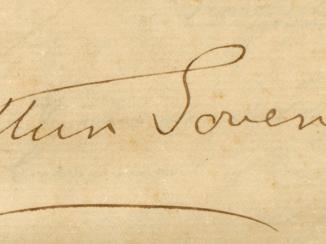Overview
‘Īsá bin Ṭarīf Āl Bin ‘Alī (الشيخ عيسى بن طريف آل بن علي) was a notable Arab shaikh of the early nineteenth-century Gulf, described by John Lorimer as ‘a daring and energetic leader’ and an ‘adventurer.’ He was born in Qatar at Zubarah 18th-century town located 105 km from Doha. around 1790 and, at some point in the 1820s, became the Shaikh of the Āl Bin ‘Alī (آل بن علي) tribe, a branch of the famous Al-‘Utūb (العتوب) tribal confederation that included the Āl Ṣabāḥ of Kuwait, the Āl Khalīfa of Bahrain, and the al-Jalāhimah of Khor Hasan (now Khuwair) and Ruwais in northern Qatar. The Āl Bin ‘Alī were one of the ‘maritime Arab’ tribes that roamed the sea instead of the desert. By profession, they were mariners (sailors and pearl divers) and merchants, sailing and trading as far away as India and Africa. Their dhows flew a distinctive flag of horizontal red-and-white stripes known as the Sulaimi flag, after the alternative name by which the tribe is known: the Āl Sulaim (آل سليم). The tribe had settlements on both shores of the Gulf, but was concentrated in Qatar, Bahrain, and Kish island off the coast of Iran.
The rulers of Bahrain, Abu Dhabi, and Oman regarded ‘Īsá bin Ṭarīf as a much sought-after ally, and he was the brother-in-law of Shaikh ‘Abdullah bin Aḥmad Āl Khalīfa (Ruler of Bahrain, 1796–1843). He was Governor (Wālī) of Huwaila on the northeast coast of Qatar from sometime in the 1820s up to 1835, after which he and his tribe relocated to Abu Dhabi for the rest of the decade. One of his most celebrated achievements was his remarkable capture of Fort Jesus (an old Portuguese fort) at Mombasa in the name of the Sultan of Oman and Zanzibar, Sayyid Sa‘īd bin Sulṭān, in 1837. The report on the capture can be read here. In 1839, shortly after the Āl Bin ‘Alī returned from the annual pearling season in September, ‘Īsá bin Ṭarīf led his tribesmen to Kish island in Iran, where he became Governor.
Four years later, soon after the conclusion of the 1843 pearling season, ‘Īsá bin Ṭarīf and the Āl Bin ‘Alī left Kish island for Biddah, where they seized the governorship of the town (and most likely the adjacent town of Doha) from the Shaikh of the Sūdān tribe, Sālmīn bin Nāṣir al-Suwaidī, forcing him and his tribe out of Qatar. At the time, Biddah and Doha were separate towns, situated half a mile apart, as can be seen in this map from 1823.
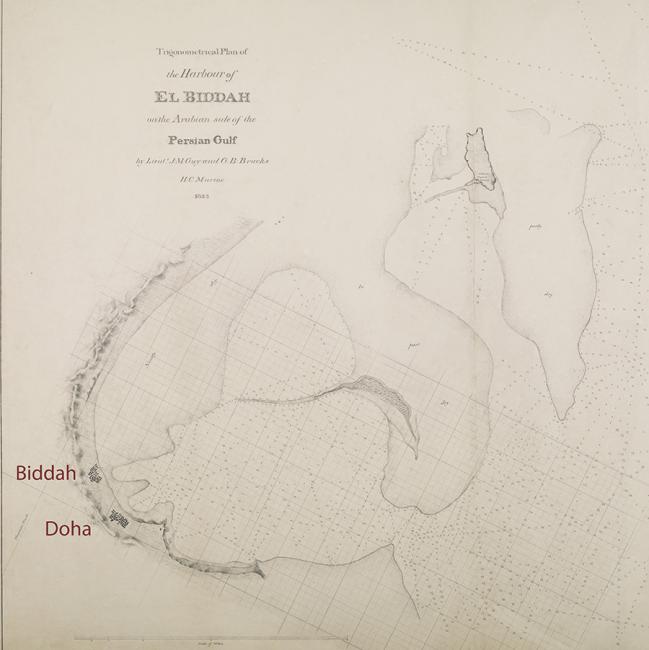


Each town had a fort, with Biddah’s being the larger of the two and the seat of the principal governor of the area.
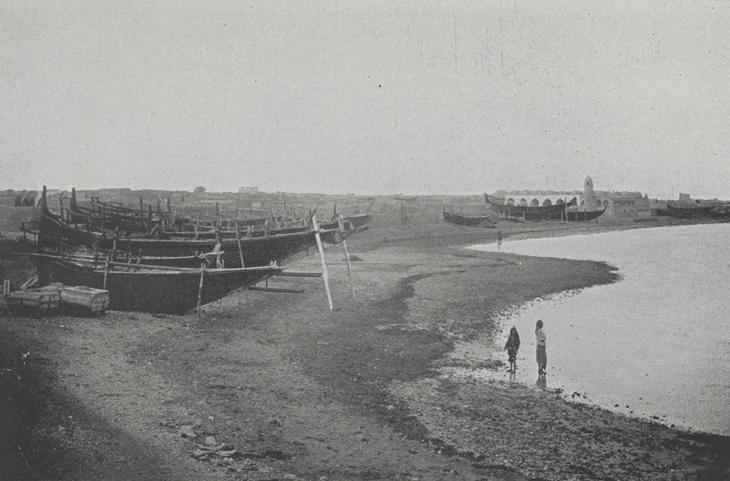
We know of ‘Īsá bin Ṭarīf’s relocation to Biddah because of a letter he wrote to Britain’s senior political representative in the Gulf, Captain Samuel Hennell, the Gulf Resident, stationed at Bushehr (Bushire) on the Iranian coast. In it, he states that:
I write to inform you that I was honoured by the receipt of your kind and friendly letter informing me of your arrival in these parts. I was greatly rejoiced, since your friendship is of old date and I hope in God the same will continue […] We have settled on the Guttur [Qatar] coast to the southward, at Biddah, and our affairs are peaceful and amicable.
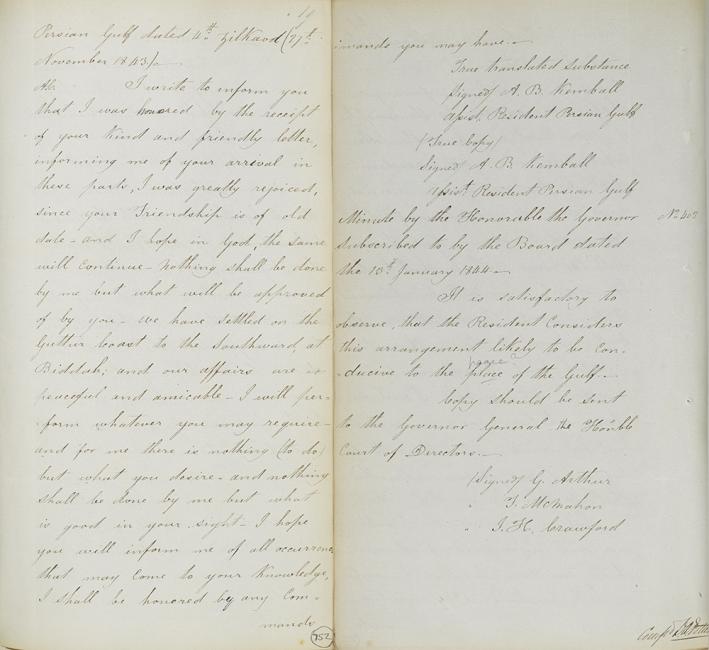
This translation of the letter is by the Assistant Gulf Resident, Arnold Kemball; the Arabic original does not survive. The letter’s tone is typical of diplomatic correspondence from that era. Gulf rulers and governors employed a degree of flattery that seems a bit excessive by present-day practice. But ‘Īsá bin Ṭarīf was also motivated by another concern: Britain was the leading world power in the region at the time and he needed to make a favorable impression on Samuel Hennell. If Hennell viewed his recent move to Biddah as a potential threat to the peace and stability of Qatar, he might take action against him. Seen in this context, ‘Īsá bin Ṭarīf’s letter gives us a glimpse into the world of nineteenth-century Gulf diplomacy, revealing him to be a skilled and persuasive diplomat.
‘Īsá bin Ṭarīf’s letter worked, for Hennell reported the development to his superior in Bombay in a very favorable light:
I have the honor to enclose for the information of the Hon’ble the Governor in Council the accompanying translation of a letter from Shaik Esa bin Tarif, the Head of the Ali Ally tribe, announcing that he and his followers have removed from the Island of Kenn [Kish] and taken up their abode at Biddah.
I consider this arrangement to be in every respect highly satisfactory. It brings Esa bin Tarif and his tribe within the Arabian side of the restrictive line, while, at the same time, it places Biddah (a port exceedingly difficult to access) in the person of that Chief a Ruler in whose sincere wish to put down all irregularities at sea of a piratical nature, I place the utmost confidence. In this respect the inclinations of Bin Tareef are widely different from those of Salmin bin Naser Sooweedee, the former Shaik of Biddah, who was strongly suspected, and I believe very justly, of secretly protecting and encouraging predatory characters, in whose ill-gotten spoils he did not scruple to participate.
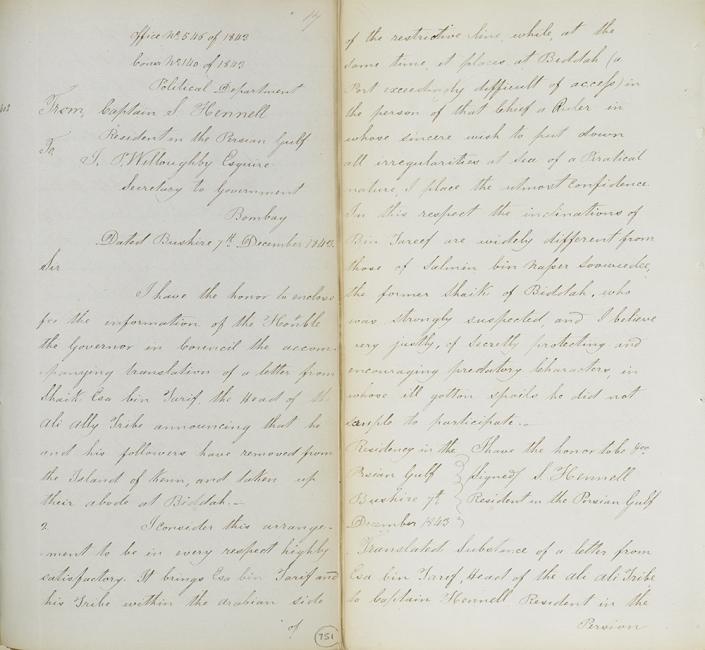
The ‘restrictive line’ that Hennell refers to was a line imposed by Britain in 1836 separating the Arabian and Iranian sides of the Gulf. The rulers of Bahrain, Qatar, and the Trucial Coast A name used by Britain from the nineteenth century to 1971 to refer to the present-day United Arab Emirates. (now the UAE) were forbidden from engaging in maritime warfare or raiding north of the line in order to safeguard the international shipping lanes off the Iranian coast, which were heavily used by British Indian ships.
‘Īsá bin Ṭarīf’s governorship of Biddah and Doha was peaceful until he became involved in a succession battle over the rulership of Bahrain in 1847. That year, he attempted to help his brother-in-law, Shaikh ‘Abdullah bin Aḥmad Āl Khalīfa, regain his rulership of Bahrain. In response, the new Ruler of Bahrain, Shaikh Muḥammad bin Khalīfa Āl Khalīfa, sailed to Qatar with a military force to confront ‘Īsá bin Ṭarīf. On 17 November 1847, the two sides clashed at Umm al-Ṣuwayyah near Al-Khor (some accounts say Fuwairit). The battle lasted half a day. At its end, ‘Īsá bin Ṭarīf along with eighty of his men lay dead on the battlefield. Following the battle, Sālmīn bin Nāṣir al-Suwaidī returned to the governorship of Biddah and Doha, but his governorship was short-lived. By 1850, possibly earlier, his place had been taken by the Governor of Fuwairit, Shaikh Muḥammad bin Thānī, after which he and the Āl Thānī family rose to prominence, eventually becoming the rulers of Qatar as a whole.








